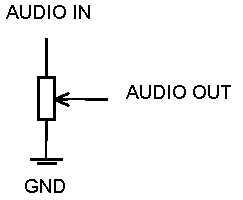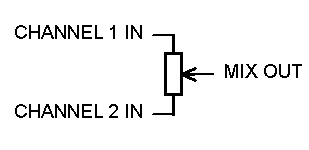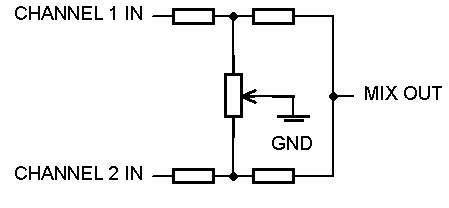Crossfader circuit
Contents
Mixer requirements
Turntablists have the following requirements in a mixer circuit:
- Small off-to-on travel distance - the appropriate channel should be fully muted when the fader is in the zero position, and bring the channel to full volume within the first few millimetres of wiper travel.
- Decay time - when the fader is moved, the appropriate channel should change volume at a rate quickly enough to allow rhythmic cutting, but slowly enough to eliminate any clicks and pops which would be caused by an instantaneous decay
Design Approaches
Early simple circuits
Initial mixer circuits used the crossfader as a component in the audio signal path. This kept the number of components to a minimum, but were very susceptible to wiper noise, and could not support features such as curve control or decay time.
One resistive element per channel
The first crossfader circuits were very simple :
These circuits ran the audio signal through the carbon track, with ground at the other end, and operated like a voltage divider. The wiper pin served as the audio out, and would produce a signal proportional to the distance from the audio source.
This approach required a separate carbon track for each channel, so for two stereo channels four tracks were required. Faders with this configuration were expensive and generated a lot of friction due to the large contact area required.
Tapped circuit
Alternatively, both channels can be connected to the same resistive element, using the wiper as a tap :
This has the benefit of only requiring one resistive element per output channel, but has issues with impedance and crosstalk, and usually requires buffering on the inputs and outputs. Also, it requires a potentiometer with a Sigmoid or "W" taper, which are fairly nonstandard, and many faders with this approach use faders with a less-than-ideal linear taper instead.
Ground pulldown
Another topology to consider effectively uses the wiper as a pulldown resistor that can be moved to either channel freely :
This has much reduced crosstalk and again requires only one resistive element per output channel, but also significantly attenuates the signa, so will adversely affect the signal-to-noise ratio of the circuit. It also requires a sigmoid-taper fader as before.
Mixers that use this topology include :
- Technics SH-DJ1200
- Essentially everything before the Vestax PMC Pro series
Voltage controlled amplifiers
In the mid-90s, performance mixers based on Voltage Controlled, or Variable-gain, amplifiers started to appear. In these designs, no audio signal passes through the fader - instead, the fader generates a voltage that is used to control an active electronic circuit, which in turn changes the volume of the signal. This approach has many advantages over earlier circuits, such as :
- Filtering - The control voltage can be low-pass filtered to remove wiper noise from the signal. This greatly increases the lifespan of carbon-track faders, as minor wear on the resistive element has less of an effect on the output.
- Reduced Interference - Faders have the disadvantage that they are susceptible to electrical interference. By keeping the audio signal path and control circuit separate, this source of noise is reduced.
- Cheaper Faders - VCA circuits can be made using cheaper logarithmic or linear taper faders, and with appropriate circuitry a single resistive element can control two entire stereo channels (although most VCA mixers use faders with two elements to simplify processing).
- Curve Control - The fader control voltage can be processed to reach full gain before the end of the wiper travel.
There are a number of approaches to VCA circuit design :
Optocoupler-based
The optocoupler design uses the control voltage from the fader to drive an LED, which in turn affects the resistance of a photoresistor. This gives a output volume proportional to the voltage input:



